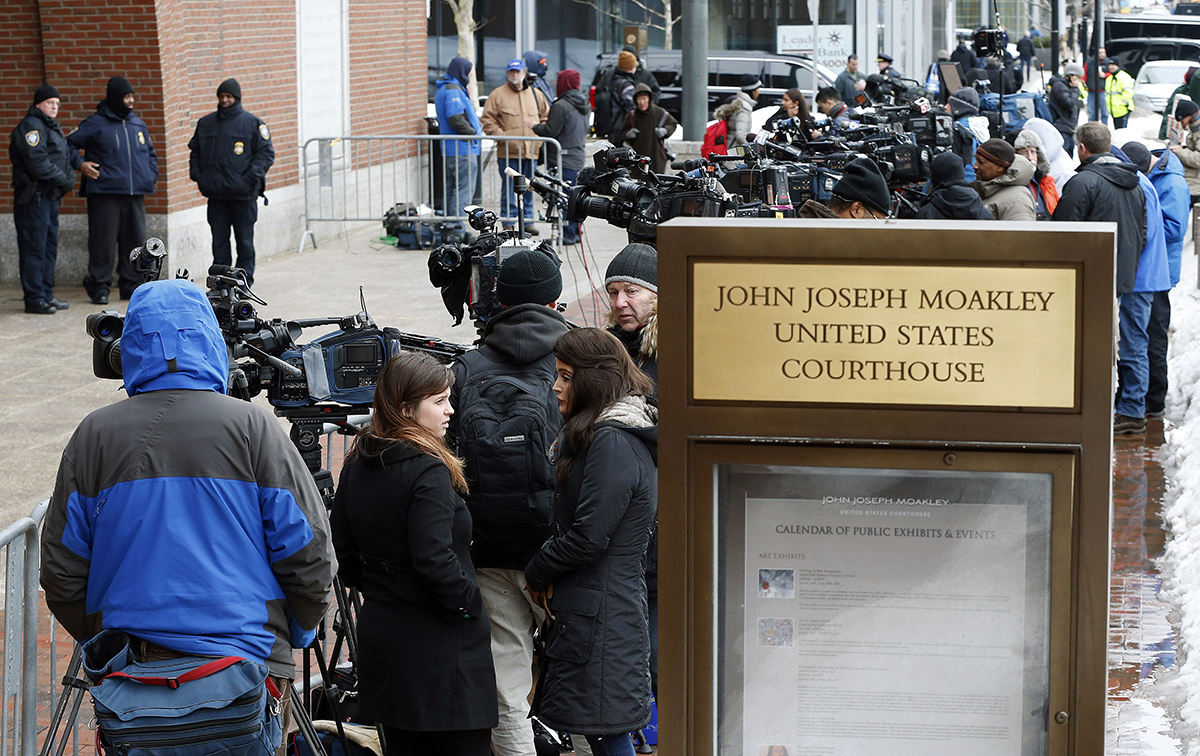Dzhokhar Tsarnaev Trial Gets Underway with Opening Arguments

Photo via AP
What drove Dzhokhar Tsarnaev to Boylston Street? Why the backpack, the shrapnel, the wounded, the dead?
As the Dzhokhar Tsarnaev trial opened today, prosecutors and his lawyers told their competing stories of why he stopped in front of the Forum restaurant on Patriots Day 2013, why he laid his backpack on the ground and why, as all other eyes turned toward the first explosion, he turned away and rushed off, seconds ahead of the second blast.
To prosecutor William Weinreb, Tsarnaev is a terrorist zealot, a young man who turned radical in secret, who spent two years studying al-Qaeda’s provocations and learned its methods of murder.
Judy Clarke, for the defense, put up no fight over Tsarnaev’s guilt in the bombings, nor over Weinreb’s narrative of the attack, the horrors of the fatal wounds to Martin Richard, Lingzi Lu, Krystle Campbell, and the shooting death of MIT police officer Sean Collier.
“It was him,” she said. Instead, Clarke cast Tsarnaev’s older brother, Tamerlan, as the plot’s mastermind, the overbearing influence who radicalized and recruited the young man Clarke called by his nickname, Jahar.
To learn Tsarnaev’s thoughts, both lawyers turned to Tsarnaev’s laptop and the dry-docked boat in Watertown. They debated the jihadist lectures and writings found on Tsarnaev’s computer and the confession he scrawled in pencil on the wall of his last hiding place.
“I ask Allah to make me a shahid,” or martyr, and “to allow me to return to him,” Weinreb read, quoting from Tsarnaev’s writing on the wall.
Tsarnaev “believed what he had done was good, was something right,” Weinreb argued. “He believed he was a soldier in a holy war against Americans. He believed he had won an important victory in that war by killing Martin Richard, Lingzi Lu, and Krystle Campbell.”
Weinreb said Tsarnaev’s “transformation into a terrorist” took “a year or two”—and his computer proved it. “The defendant’s computer is a window into his life, especially into the part of his life he kept mostly hidden from his friends,” Weinreb said.
Tsarnaev started reading and posting about radical Islam in 2011 and was listening to radical lectures and songs by 2012. “He told a friend he had a plan to reach paradise,” Weinreb said. Evidence on his computer, he said, includes a near-complete set of Inspire, the English-language magazine of al-Qaeda in the Arabian Peninsula. One issue, he noted, explains how to build a homemade bomb and “recommends placing it in a crowded area to maximize its deadly effect.”
Clarke, whose real job is to convince the jury to spare Tsarnaev’s life, said the defense and prosecution will often agree during the trial. They’ll disagree, she said, about why the crimes happened.
“It was Tamerlan Tsarnaev who self-radicalized,” Clarke argued. “It was Dzhokhar who followed him.”
She conceded that the younger man had “extremist materials” on his computer, including Inspire. But she asked the jury to follow the computer forensics to learn how they got there. A flash drive, she implied, would show that Tamerlan, 26 at the time of the bombings, passed much of the incriminating material to his younger brother, then 19.
“While Tamerlan was immersed in death, destruction, and carnage in the Middle East, Dzhokhar did things teenagers do: Facebook, cars, girls,” Clarke said. “The evidence will also help point you to understanding the flow of the materials. Who got what first? Who got the most? Who had the most?”
Clarke asked the jurors to read all of Tsarnaev’s pencil scrawls on the boat’s wall. “[He] expressed jealousy of his brother, who had achieved martyrdom, his wish he would as well. He wrote [that] he perhaps guessed he was alive to shed some light on their motives. He wrote words he’s read and heard, that the United States is responsible for the suffering of Muslims around the world.”
She asked the jury to “carefully evaluate these writings inside the boat: where they came from, and how deeply rooted they may or may not be.”

